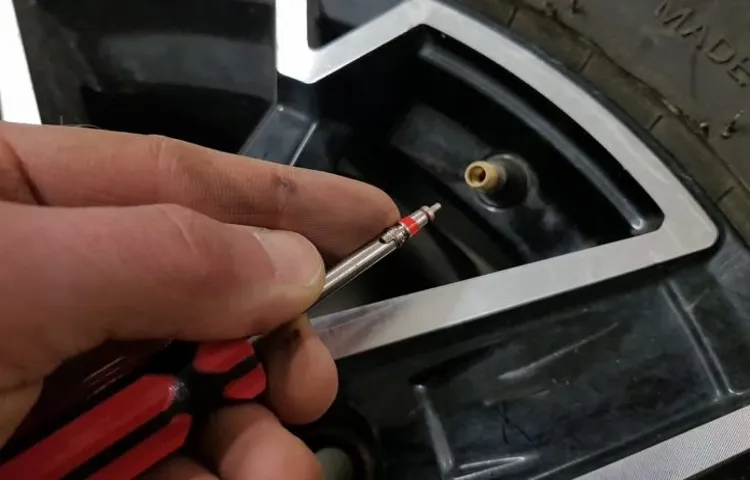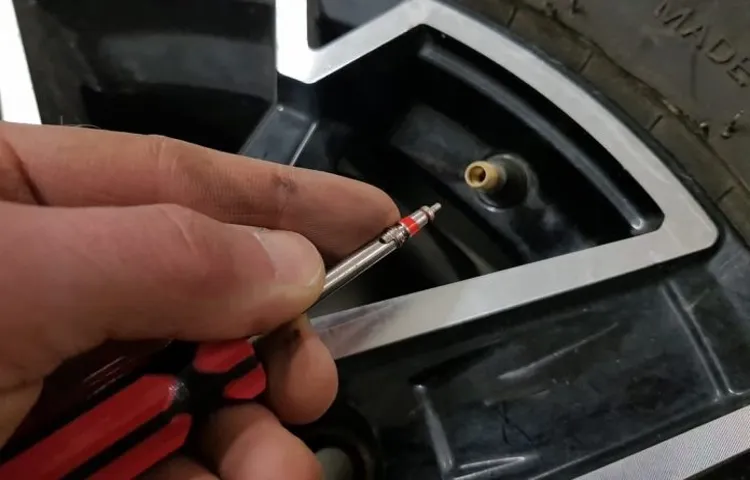If you’re a car owner, you know the importance of maintaining your vehicle regularly. While some tasks require professional attention, others can be done at home with minimal effort. Removing a tire valve stem is one such task that, if done correctly, can save you a trip to the mechanic and a few bucks.
The valve stem is the tiny protrusion sticking out of your tires that allows for air to be pumped inside. Over time, it can get damaged or start leaking, leading to issues with tire pressure. That’s why it’s essential to know how to remove and replace a valve stem in case of an emergency.
But where do you start? If you’re a beginner, the thought of removing a tire valve stem might be intimidating. That’s precisely what this guide is for. Here, we’ll walk you through the step-by-step process of removing a tire valve stem, from gathering the necessary tools to reattaching the new valve stem securely.
You don’t need to be a car expert or have any prior experience to follow this guide. All you need is a few basic tools and some patience. So, why wait? Let’s get started by exploring what a tire valve stem is and why it’s critical to keep it in good condition.
By the end of this guide, you’ll have all the knowledge you need to tackle this task confidently. Who knows, the next time your tire pressure is low, you might not need to call for help!
Table of Contents
Preparation
If you’re wondering how to remove a tire valve stem, the first step is to prepare your tools for the job. Start by gathering up a valve stem removal tool, which is a special pliers-like instrument used for removing and replacing valve stems. You can find these tools at most auto parts stores.
Once you have your valve stem tool, you’ll also need a valve core removal tool, a tire iron, and a wrench. Make sure to have all of these tools on hand before you begin, as having to pause in the middle of the job to go look for a missing tool can be frustrating and time-consuming. Another important aspect of preparation is safety – before starting any tire work, make sure your car is on level ground, the parking brake is engaged, and the wheels are chocked.
This will keep the car from rolling or moving unexpectedly while you’re working on the tires. With your tools and safety precautions in place, you’re ready to move on to the next step of removing the tire valve stem.
Gather Necessary Tools
Preparing for a project is just as crucial as the implementation. One of the first steps in preparation and making sure that your work will go efficiently is gathering the necessary tools. Whether it’s a hammer, screwdriver, or drill, make sure you have the tools you need before beginning the job.
Not having the right tools can cause frustration, delays, and even injury. It’s essential to take inventory and double-check that you have all the necessary equipment before starting. If you don’t have a particular tool, research where to buy it or see if you can rent it.
This attention to detail in preparation will save you time, money, and stress in the long run and make the project run more smoothly. Remember, with the right tools, you can take on any task with confidence and ease.

Park the Vehicle and Securely Place Jack Stands
Preparing to work on a vehicle is essential, and one of the most crucial steps is to park it on a level surface. Once you have found a good spot, make sure to engage the parking brake and switch off the engine before getting to work. To ensure that the vehicle doesn’t move, you will need to use jack stands.
Jack stands allow you to lift the vehicle off the ground and keep it securely in place while you do your repairs. Before attempting to use the jack stands, you should ensure they’re the correct size and strength for your vehicle. Most importantly, you need to place them in the right spots to properly support the weight of the car.
It’s best to position them near the vehicle’s jack points to ensure they can bear the load. Carefully raise the vehicle, place the jack stands, and then lower the car onto the stands. Make sure that the stands are level and in place before you work on the vehicle.
By taking these steps, you can ensure your safety and work with the peace of mind knowing that the vehicle is secure.
Removing the Tire Valve Stem
Removing a tire valve stem may seem like a daunting task that requires professional help, but it is actually a simple process that can be done at home with the right tools. To remove a tire valve stem, you will need a valve core removal tool and pliers. First, use the valve core removal tool to unscrew the core from the stem.
Once the core is removed, use the pliers to pull the valve stem out of the tire. Be sure to hold the stem steady while pulling it out to prevent damaging the tire. After the stem is removed, clean the area around the valve hole and insert a new valve stem.
This process can save you money and time compared to bringing your tire to a professional for a simple valve stem replacement. Remember, safety always comes first when working with car tires, so make sure to wear proper protective gear and follow all safety precautions.
Deflate the Tire
Deflating the tire is an important step before removing the tire valve stem. You don’t want a blowout or to damage your valve stem in the process. Luckily, deflating a tire is easy! First, locate the valve stem and remove the valve cap.
Then, use a valve core removal tool (or a small pliers) to depress the valve core and release the air from the tire. It may take a few minutes, but you should hear the air hissing out. Once you hear no more air escaping, you can be sure the tire is fully deflated.
It’s important to note that if you have a spare tire, you’ll want to inflate it before putting it on your vehicle. And if you’re using a tire repair kit, the instructions may require a fully deflated tire before proceeding. In any case, deflating the tire is an important step in the tire repair process.
Remove the Valve Cap
Removing the tire valve stem requires a few simple steps, the first of which is removing the valve cap. This small cap sits on top of the valve stem and protects it from dust and debris. It’s important to remove the cap carefully to prevent any damage to the stem.
To do so, simply twist the cap counterclockwise until it comes off. If the cap is too tight, use a pair of pliers to help loosen it. Once the cap is removed, you will be able to access the valve stem and complete the next steps in the process.
Remember, taking care of your valve stem and cap can help prolong the life of your tire and ensure that it performs safely on the road.
Detach the Valve Stem Locking Nut
The process of removing a tire valve stem begins by detaching the valve stem locking nut. This might seem like a complicated task; however, it’s quite straightforward. The valve stem locking nut is a small but critical component that holds the valve stem in place, preventing air from escaping from the tire.
Therefore, once you have removed it, the tire valve stem will easily come out. Before that, you have to ensure that the tire is fully deflated to avoid damage to the valve stem or injury to yourself. You can use a valve stem removal tool or pliers to loosen the locking nut by turning it counterclockwise.
Once it’s loose enough, you can use your fingers to remove it. With the locking nut out of the way, you can proceed to remove the tire valve stem by pulling it out of the valve stem hole on the rim. In conclusion, removing a tire valve stem is a simple process that requires only a few minutes of your time.
However, it’s crucial to ensure that you handle all components with care to avoid causing any further damage or injury.
Insert Valve Stem Tool and Rotate Counter-clockwise
When it comes to removing your tire valve stem, the first step is to grab your valve stem tool. This handy little tool is essential for removing the valve stem and can be found at most auto parts stores. Insert the tool into the valve stem and turn it counter-clockwise.
You may have to use a bit of force, but with a little persistence, the valve stem should start to loosen up. Keep turning until the valve stem is completely removed from the tire. Be careful not to damage the tire or the rim in the process.
Once the valve stem is out, you can move on to replacing it with a new one. This is a simple process, but it’s important to take your time to ensure you do it correctly. With a little practice, you’ll be a pro at removing and replacing tire valve stems in no time!
Gently Pull Out the Valve Stem
Removing the tire valve stem is a crucial step when changing tires. To remove the valve stem, start by unscrewing the valve cap and using a valve core remover tool to remove the inner valve. Next, use pliers or a valve stem puller tool to gently pull out the valve stem from the rim.
It’s essential to be careful as excessive force can damage the rim, causing more significant problems. Once out, inspect the valve stem for any damage or wear and replace if necessary. Removing the valve stem allows for easy access to the tire’s interior, making it easier to change the tire or repair a puncture.
Remember to always use caution when removing valve stems to avoid damaging the rim and ensure your safety.
Installing a New Tire Valve Stem
If you’ve got a leaky valve stem, you’ll want to remove it and replace it with a new one. But how do you do that? The first step is to remove the valve cap and use a valve core removal tool to release the air pressure from the tire. Once the tire is deflated, use a valve stem removal tool to unscrew the old valve stem from the rim.
Make sure to push the tire out of the way so you can access the valve stem from the inside of the rim. Once the old stem is removed, clean the inside of the valve stem hole with a wire brush to remove any corrosion or debris. Then, install the new valve stem and tighten it with a valve stem installation tool.
Finally, inflate the tire to the recommended pressure and replace the valve cap. Voila! Your tire is now ready for the road again.
Clean and Lubricate Valve Stem Hole
When installing a new tire valve stem, it’s crucial to ensure that the valve stem hole is clean and lubricated. This is because any dirt or debris in the valve stem hole can compromise the seal and cause air leaks. To clean the valve stem hole, start by removing any debris or old rubber from the area.
Then, use a valve stem cleaner or a small brush to clean the inside of the hole thoroughly. Once the hole is clean, apply a small amount of lubricant to the valve stem before inserting it into the hole. This will help to ensure a tight and secure seal, preventing any air leaks.
Remember to use caution when installing a new tire valve stem, and take your time to ensure that the job is done correctly. By taking these steps, you can ensure that your tire valve stem is installed properly and operating at maximum efficiency.
Insert New Valve Stem and Tighten Locking Nut
Installing a new tire valve stem may seem like a small task, but it is crucial for the overall safety and efficiency of your vehicle. The first step is to locate the old valve stem and remove it using a valve stem removal tool. After removing the old stem, take the new valve stem and insert it into the valve stem hole.
Make sure it fits snugly and is secure. Next, grab a locking nut and tighten it onto the base of the valve stem. It’s important to tighten the nut enough to secure the new valve stem but not so tight that it damages the valve stem or the tire itself.
A good rule of thumb is to tighten the locking nut with your fingers and then use a wrench to give it one or two final turns. Once everything is tightened up, inflate the tire and check the tire pressure to ensure that the new valve stem is functioning properly. By taking these few simple steps, you’ll have a safe and secure tire that’s set for the road ahead!
Inflate the Tire and Check for Leaks
When it’s time to install a new tire valve stem, there are a few steps you’ll need to follow to ensure you get the job done right. First, remove the old valve stem from the tire using a valve stem tool. Then, take your new valve stem and insert it into the hole, making sure it’s seated properly and tightly secured.
Next, use a valve stem tool to screw on the locking nut and tighten it down. Once your new valve stem is in place, it’s time to inflate the tire and check for leaks. Inflating the tire is a critical step in ensuring your new tire valve stem is properly installed.
Start by connecting your tire inflator to the valve stem and adding the appropriate amount of air. Be sure to use a tire pressure gauge to check the pressure and adjust it as needed. Once the tire is fully inflated, spray some soapy water onto the valve stem and surrounding area to check for leaks.
If you notice any bubbles forming, you may need to tighten the locking nut a bit more to ensure a proper seal. Overall, replacing a tire valve stem isn’t too difficult if you have the right tools and follow the proper steps. With a little bit of patience and attention to detail, you can have your new valve stem installed in no time, and your tire will be ready to hit the road again in no time!
Conclusion
In conclusion, removing a tire valve stem can be a daunting task for even the most seasoned mechanic. But fear not, with a bit of patience, the right tools, and a touch of finesse, you too can swap out that pesky valve stem with ease. And who knows, maybe you’ll even impress your friends with your newfound knowledge of tire valve maintenance.
As they say, knowledge is power, and in this case, it’s the power to conquer any valve stem removal challenge that comes your way. So take a deep breath, channel your inner mechanic, and get ready to tackle that tire valve stem like a pro!”
FAQs
What tools do I need to remove a tire valve stem?
You will need a valve stem removal tool, pliers, and a valve core removal tool.
Can I replace a tire valve stem myself?
Yes, you can replace a tire valve stem yourself with the proper tools and instructions.
How do I know if my valve stem needs to be replaced?
If you see cracks or damage on the valve stem or if it is leaking air, it may need to be replaced.
Is it safe to drive with a damaged valve stem?
No, it is not safe to drive with a damaged valve stem as it can cause a flat tire or blowout.
Can I use any type of valve stem on my tires?
No, it is important to use the proper valve stem for your specific tire and vehicle make and model.
What is the average cost to replace a tire valve stem?
The cost to replace a tire valve stem can vary depending on the make and model of your vehicle, but it typically ranges from $20 to $50.
How often should I check my tire valve stems?
It is recommended to check your tire valve stems every time you check your tire pressure, which should be at least once a month.



